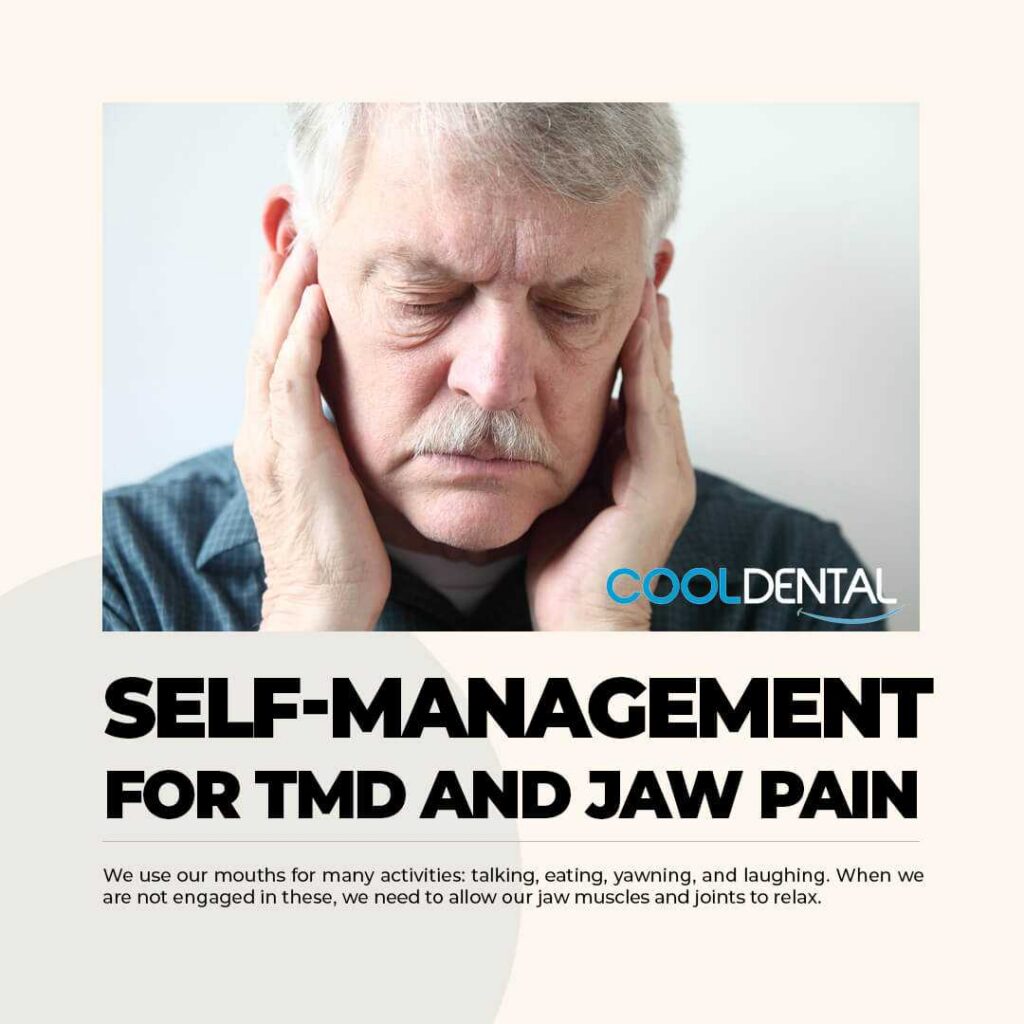We use our mouths for many activities: talking, eating, yawning, and laughing. When we are not engaged in these, we need to allow our jaw muscles and joints to relax. Research shows that significant pain reduction and improved function can be obtained with self-management. The steps listed below will help you learn to relax these muscles and joints -and reduce the jaw pain you are experiencing.

1. Eat soft foods. Confine your diet to soft foods such as casseroles, canned fruit, soups, eggs and yogurt. Do not chew gum or eat hard foods (such as raw carrots) or chewy foods (such as caramels, steak or bagels).Cut other food into small pieces, and chew on both sides of your mouth simultaneously to reduce the strain on one side.
2. Rest your jaw muscles. Keep your teeth apart and practice good posture. When you are not chewing your teeth should never touch (except occasionally when you swallow). Closely monitor your jaw position for signs of clenching. Try placing your tongue lightly on the top of your mouth behind your upper front teeth, allowing the teeth to come apart and relaxing the jaw muscles.
Good head, neck and back posture help maintain good jaw posture. Try to hold your head up straight, and use a small pillow or rolled towel to support your lower back.Avoid habits such as resting your jaw in your hand or cradling the telephone against your shoulder.
Some simple exercises are effective in improving muscle and joint function, reducing day and night time clenching and reducing pain. Repeat these simple exercises as often as possible during the day.
N-Position Exercise. This is a very effective muscle relaxation exercise. When we say the “N” sound; our tongue rests on the bony platform behind the upper front teeth. Place the tongue in the N-position. Image the jaws and mouth are hanging from the tongue and the lips are slightly parted. Let the jaw muscles go limp. You should feel the jaw muscles let go of their tension. Try to keep the teeth apart and the tongue in the N-position during the day. Studies have shown that this exercise can reduce the amount and intensity of nighttime clenching.
Jaw Stretches Two stretches are use to loosen tight jaw muscles. The first is a regular stretch of the jaws where you open as far as possible. (Note: If your problem includes hyper-mobility problems [open locking], do not do these stretches!) The second stretch is performed by placing your tongue in the N-Position and opening as wide as possible. This stretch works on the deeper part of the jaw muscle which regular stretches do not help.
Hinge Exercise. This exercise disturbs the habit of jaw clenching and moves helps lubricate the internal joint surfaces. This exercise is done by rapidly opening and closing your mouth. Repeat the cycle ten times rapidly. The opening should be no more than the width of your thumb. Do not hit your teeth together.
3. Heat Treatment. Applying moist heat to painful muscles will increase circulation and help reduce waste products from your muscles. Apply moist heat (such as hot moist towels) to the painful areas of the head and neck. Most people prefer heat, but ice (a bag of frozen peas works well) is also effective.
- Do not put ice directly against skin, rather wrap in a thin cloth.
- A damp hand towel heated in a microwave oven works well for moist heat.
- Apply moist heat (or ice) for a total of twenty minutes two to four times each day.
- Leave on for five minutes-then remove for five minutes to allow skin to rest in between applications.
4. Avoid caffeine. Caffeine stimulates your muscles to contract and become tenser. Caffeine and caffeine-like drugs are in coffee, tea, most sodas and chocolate. Reducing caffeine use can significantly reduce muscle tension.
5. Sleep smart. Avoid sleeping habits that strain your jaw muscles or joints. Don’t sleep on your stomach, and if you sleep on your side, keep your neck and jaw aligned.
6. Use medications. Use anti-inflammatory and pain-reducing medications like Aleve, ibuprofen (Motrin), Tylenol, and aspirin to reduce joint and muscle pain.Avoid medications with caffeine, such as Anacin or Excedrin. Be aware that continued use of the medications can cause “rebound headaches” when patients suddenly stop taking the meds.



